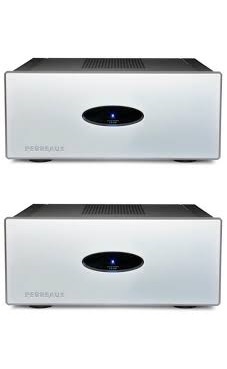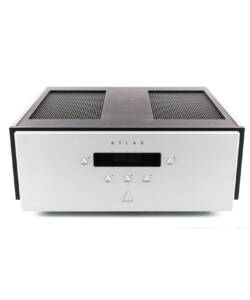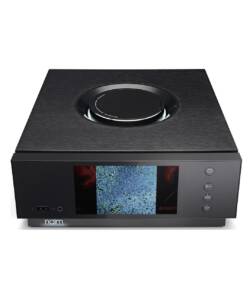Parasound 200 Preamp & 275 MK2 Power Amplifier
Original price was: R78,000.00.R32,000.00Current price is: R32,000.00.
Parasound NewClassic 200 Pre Preamplifier-DAC
In July of this year I auditioned Parasound’s Halo A 23+ power amplifier and found it an exceptional performer for the price at $1495 USD. Parasound also sent me their NewClassic 200 Pre preamplifier-DAC ($895), a slim, solidly constructed model that occupies only a single rack space. I wondered if it could match the Halo A 23+ in quality of sound for dollars spent.
Description
The NewClassic 200 Pre’s controls are few — Power and Mute buttons, Volume and Input knobs — but it covers everything critical, whether from its front panel or its backlit remote control. Press Input to cycle through settings for bass, treble, balance, and subwoofer level. A small display with green characters on a background of lighter green — not the easiest to read, and a bit old-fashioned — shows the input selected (the inputs can be renamed) and the volume level, and other settings when those are activated. Also on the front panel are an auxiliary input and a headphone output, both on 3.5mm minijacks.

On the rear panel is an impressive array of connections new and old. The 200 Pre’s Burr-Brown PCM1798 DAC chip supports two-channel PCM digital at resolutions up to 24-bit/192kHz via the optical TosLink and coaxial S/PDIF inputs, and up to 96kHz via USB. The 200 Pre’s phono stage supports moving-magnet (47k ohms input impedance) and moving-coil (100 ohms) cartridges. When not connected to a phono-level source, Input 1 can be set to line level, to bring the 200 Pre’s total number of line inputs to three. Input 3 is shared with and preempted by the front-panel Aux input, which offers an additional 12dB gain, appropriate for the headphone jack of a portable media player or smartphone. The 200 Pre also has a bay of Bypass inputs on RCA jacks for A/V receivers and source components that have their own preamp-level outputs. With Bypass selected, the 200 Pre gets out of the way, not impacting volume, treble, bass, balance, or crossover. Conveniently, when the 200 Pre is switched off it automatically goes into Bypass mode.

After following a pure analog signal path, music signals are sent to the 200 Pre’s unbalanced main, subwoofer, recording, and headphone outputs. While the recording output level is fixed, all other outputs are affected by the 200 Pre’s volume, treble, bass, and balance settings, and one subwoofer output includes a crossover. Yes, the 200 Pre has two subwoofer outs: one is full-range, relying on the sub’s own crossover; the other uses the 200 Pre’s built-in high-pass/low-pass crossover with analog bass management. Using a dial on the rear panel, the High Pass Crossover frequency can be set anywhere within the range of 20-140Hz. When this crossover is activated with a little switch just above this dial, it blocks all frequencies below the frequency set on the dial from being sent to the 200 Pre’s main channel outputs. (Until reading about this feature in the manual, I wondered where my low midrange had gone.) For system integration, Parasound provides an RS-232 port, a wired IR input, and a 12V trigger output. Finally, input level offsets and default power-on volume settings can be configured from the remote control.
Setup and system
For most of my listening, I used the NewClassic 200 Pre’s built-in DAC and phono stage. Using the included cable, I linked the 12V trigger ports of the 200 Pre and Parasound’s Halo A 23+, and set the power amp to turn itself on when the preamp sent it a trigger signal. As I’d placed the amp atop the preamp, this configuration made sense. The audio-sensing option worked reliably as well.
My primary source components were a Music Hall MMF CD-25 CD player ($600 when available) and a Cambridge Audio CXN (V2) network player ($899.99), used as both analog and digital sources. At the other end of the signal chain were Sonus Faber Principia 3 stand-mounted loudspeakers.
Sound
I spent most of my listening time sending digital signals to the NewClassic 200 Pre and comparing it to the other options in my rack. Because with my Cambridge CXN (V2) network player I can control the volume and switch the output level from line to preamp, I sent the CXN’s unbalanced analog signal straight to a power amplifier. The CXN’s output level is much higher than the Parasound’s, but once I’d matched the levels it was immediately clear that adding the extra circuitry of the preamp was beneficial. With the 200 Pre bypassed, the control over the sound was looser, less definitive. Dynamic variations were also lessened. I also had to integrate my active subwoofer into the system by running the signal through the sub’s somewhat noisy crossover circuitry. My NAD C 356BEE integrated amplifier ($900) has two preamp-level outputs, one of them tied via a coupler to the main input. This allows the NAD to be used either as a preamp or power amp, so I also compared the NAD’s preamp section with the 200 Pre.
Used as a preamp, the NAD fell between the Cambridge CXN (V2) and the Parasound NewClassic 200 Pre, but closer to the latter. The NAD was able to successfully integrate the sub’s output into my system’s sound, but needed to rely on the sub’s crossover — unlike the 200 Pre, the NAD has no low-pass filter. When I listened through the NAD to Gustavo Dudamel and the Gothenburg Symphony Orchestra’s recording of the rambunctious Scherzo of Bruckner’s Symphony No.9 (24-bit/48kHz AIFF, Deutsche Grammophon/HDtracks), the bass punch was there but the surrounding silence wasn’t, which limited the drama of the effect compared to the Parasound.

I next assessed the 200 Pre’s built-in DAC. Annu Salminen’s solo horn passages in Kalevi Aho’s Concerto for Horn and Chamber Orchestra, with John Storgårds conducting the Lapland Chamber Orchestra (24/96 FLAC, BIS/eClassical), were tighter and more defined through the 200 Pre’s built-in DAC than through the DAC in my NAD integrated via the NAD’s line output. I heard more detail and diction of individual woodwinds, and the soundstage was wider. Passages for full orchestra could sound a bit congested through the NAD. However, the two DACs’ reproductions of instrumental timbres and tonalities were rather similar.
When I played the cover of the Cranberries’ “Zombie” on Meiko’s Playing Favorites (24/192 AIFF, Chesky), the Parasound brought a centeredness to the reverberations of Meiko’s strummed acoustic guitar. Through the 200 Pre’s DAC there was also a bit more texture in her voice, and her vibrato was more pronounced. The greater focus extended to the subwoofer in “Crush,” in which bass notes sounded too splattered through the NAD. A drawback of the Parasound was the somewhat greater attention it paid to sibilants. But overall, these two built-in DACs sounded similar — hardly surprising, as they sport comparable Burr-Brown DACs — with the Parasound having subtle advantages.
The 200 Pre’s built-in DAC sounded a bit constrained compared to the CXN’s analog output. With levels matched, the CXN’s DAC sounded more open, with a bigger soundstage. The 200 Pre was better balanced tonally, providing nice, natural tone from a collection of horn trios by Brahms and Ligeti performed by Marie-Luise Neunecker (French horn), Antje Weithaas (violin), and Silke Avenhaus (piano) (24/88.2 FLAC, BIS/eClassical). Bell tones were rounded and even, yet something was missing in terms of detail and imaging. There was nothing offensive in the 200 Pre’s sound, but it didn’t immerse, envelop, and engage me in the music as the CXN did. The Parasound easily kept pace with the trio, managing dynamic and melodic changes while letting the pianist’s rapid left-hand runs cut through the mix at the center of the soundstage in the Scherzo (Allegro) of the Brahms Trio in E-flat, Op.40.

With Johnny Cash’s All Aboard the Blue Train (24/96 FLAC, Sun/HDtracks) the difference was less pronounced, though the Cambridge provided the deeper soundstage. The 200 Pre trimmed the reverberations around the strummed guitar, but in the instrument’s low range this made each strum more percussive. There was no real difference in the tonality of Cash’s voice, and the 200 Pre provided an insistent bass punch.
The NewClassic 200 Pre offers two ways to integrate a powered subwoofer into a system, depending on how you want to manage the crossover: in the Parasound itself, or by passing a full-range signal to an external crossover, such as those built into active subs. In either case, the 200 Pre’s subwoofer output is monaural. Its crossover frequency can be set anywhere from 20 to 140Hz — a range plenty wide enough for integrating a sub with any but the very smallest or largest speakers, as activating that crossover filters the main output. I found it easier to disable the crossover of my Wharfedale PowerCube 10 sub and use the 200 Pre’s crossover.
That done, I liked how the sub filled in the lower range, especially for pop and rock drums and electric bass. It also convincingly reproduced the doo-wop walking-bass line in “Gonna Get Over You,” from Sara Bareilles’s Kaleidoscope Heart (CD, Epic 8697550352), only the essence of which flows from my Sonus Faber minimonitors. I’m a fan of subwoofer bass subtle enough that you notice it only when it’s gone, and toggling the Sub On/Off button on the 200 Pre’s remote control during Bareilles’s “The Light” revealed how comparatively thin the sound was without the sub. This welcome and well-implemented feature is found on few two-channel preamps or integrateds.
Phono stage
I connected my Goldring GR1 turntable with Rega RB100 tonearm, and for my Goldring Elektra moving-magnet cartridge selected the MM mode of the NewClassic 200 Pre’s Input 1. There was plenty of gain and headroom to spare with Bill Evans’s Return Engagement (LP, Verve V3HB-8841). With the solo track “A Time for Love,” his piano filled the room, the sound of each keystroke tapering nicely and naturally. On that cut the piano is mixed to encompass the entire soundstage, but it returns to a more naturally proportioned size in “My Melancholy Baby,” when Evans is joined by bassist Eddie Gomez and drummer Paul Motian. The overall tonal character was relaxed and warm, but the trio’s overall image leaned to the right — again, a problem in the recording. I appreciated the 200 Pre’s accuracy in reproducing this off-kilter mix while demonstrating its impressive channel separation.
The Parasound handled a large orchestra without overwhelming the singers in Bartók’s Bluebeard’s Castle, with István Kertész conducting the London Symphony Orchestra (LP, London OSA-1158). This recording eschews sound effects, instead relying only on the score for drama. Knocking on the door, demanding the key, opening each chamber — each musical-dramatic event swelled the soundstage as the orchestra provided the aural surprise against a Gothic backdrop. Yet Judith and Bluebeard, respectively sung by mezzo-soprano Christa Ludwig and bass Walter Berry, remained consistently audible. When Judith opens the fifth door and Bluebeard sings of the grandeur of his lands, the full dynamic range the NewClassic 200 Pre could extract from an LP was evident. I was surprised at how quiet an LP could be, especially this old pressing — no doubt the result of a good phono stage not unduly amplifying surface-noise transients.

Comparing my Cambridge Audio 540P phono preamplifier ($99, discontinued) connected to one of the 200 Pre’s line inputs to the 200 Pre’s phono stage, the latter afforded a deeper, wider soundstage and warmer tonality — and, by clearing some of the haze, made possible greater dynamic range, as heard in the closing phrases of Prelude à la Nuit, from Ravel’s Rapsodie espagnole, in the recording by Pierre Dervaux conducting the Colonne Concerts Orchestra (LP, Sine Qua Non SQN-7775). Horns were punctuated and brassy in the fanfares in Malagueña, rather than brash. Along with more gain, even with levels matched, the Parasound provided a more even frequency response, particularly in the upper treble, which was too noisy through the Cambridge’s phono stage. With the Parasound, I could enjoyably listen to entire LPs. Additionally, I found the 200 Pre’s phono stage more musical than the NAD D 3020’s, which I’d liked when I reviewed it in 2018 — the 200 Pre offered a sound of greater depth and complexity.
Headphone amplifier
Recent reports from hi-fi shows have indicated the current centrality of headphones to high-end audio. But the NewClassic 200 Pre’s front-panel headphone jack — when in use, it mutes the speaker outputs — is a bit unusual. It’s a 3.5mm minijack rather than the more common 1/4” phone jack. This makes sense — most headphones I’ve encountered are terminated with miniplugs, and require an adapter to fit a 1/4” jack.

I was pleased with the sound of the Parasound’s headphone amp through my HiFiMan HE-500 cans. It had no problem driving these ’phones, with plenty of headroom. The Speakers Corner Quartet’s “Sahara,” from the compilation Accidental Powercut 1 (16/44.1 FLAC, Society of Sound Music), is a binaural recording of acoustic jazz — it had pronounced stereo separation and spaciousness as percussion entered to accompany the exposed flute at the center. I heard no self-noise from the 200 Pre’s headphone amp — the full dynamic range of this recording was available, allowing good use of silence to punctuate this performance with definitive tacets (silences). If anything, the 200 Pre had too much power — my easier-to-drive Grado SR80 headphones were deafening through most of the Parasound’s range of volume settings. The 200 Pre’s headphone amp was good enough that it let me easily distinguish between the HiFiMans’ and Grados’ reproductions of the opening drum phrases in Speakers Corner’s “Ant House” — through the Grados these sounded merely percussive, but the HiFiMans conveyed the resonances of the room and the physicality of the drums themselves.
In short, Parasound’s NewClassic 200 Pre can serve as a good headphone amp.
Wrap-up
Rather than merely checking off a list of features and connections, Parasound has provided in the NewClassic 200 Pre a high-quality, well-built preamplifier-DAC. All of the most important features are here, plus an unexpected one — the subwoofer output options — and for $895, all are well executed. The extras included — headphone amp and phono stage — are hard to imagine being bettered without a substantial increase in money spent. The NewClassic 200 Pre will easily suit many buyers, as well as make a good first step into the world of audio separates.
There are some audio brand names which are simply synonymous with home theater. But that’s not to suggest that premium component manufacturer Parasound is not as highly revered a brand among the audiophile community. Owner and CEO Richard Schram started the company in 1981. He has contrived to build an extraordinary business developing products that continue to earn choruses of approval from critics and customers alike. I have always found the small team of engineers and marketers in San Francisco – a town which itself harbors a legacy of entertainment and audiovisual prowess – to be a delight to deal with. This must in no small part be due to Schram’s own ethical approach to business and, ultimately, his obvious passion and charm. Add to the mix the electronic wizardry of circuit designer John Curl and you surely have a recipe for unbridled success. The Parasound website itself claims that the product portfolio offers “top-tier sound without breaking the bank”. Well, that just about sums it up.
Parasound’s UK representative is Connected Distribution who kindly made available a review sample of the NewClassic 275 v.2 two channel power amplifier (MSRP $749). My eyes were keenly trained on this relatively small-form-factor device, not least because of its easy 1U ‘rackmountability’ and obvious suitability to drive height or surround channels in our ever-burgeoning home theater setups.

Design and Features
Parasound’s commitment to getting things right first time around might account for not often seeing its lineup go through earth-shattering aesthetic or even internal overhauls. The company uses the carpenter’s old adage of ‘measure twice, cut once’. This seems to tie in nicely with my college tutor’s sage advice: ‘you don’t have to be different to be good; to be good is different enough’. As a sequitur, the 275 v.2, part of the NewClassic family, employs a similar front-ribbed steel fascia to the iconic Z Custom and ZoneMaster lines. Outside of the rarified air of the company’s flagship mid-high-end Halo beasts, all three aforementioned product lines mostly represent practical solutions for multi-room and low-profile custom installation applications.
The 275 v.2 offers performance and cosmetic improvements over its v.1 forebear, and can happily act as a two-channel desktop companion. More likely for our readers, though, might be its incorporation into an existing rack for additional externally powered surround channels. Built like a nuclear bunker with its rugged steel chassis and large anti-vibration feet, it’s a no-brainer for integrators to strap this armadillo to a truss or rafter (which has certainly happened to many of its siblings up until now).

As if the flexibility of 90W x 2 into 8 ohms, 150W x 2 into 4 or 2 ohms (stable) and 200W x 1 in bridged mode wasn’t enough, Parasound has thought of every permutation of possible use if you decide to repurpose the Class AB-designed v.2. Awash with features on the rear panel, there are two pairs of speaker outs (with zone A/B buttons), 12v trigger with looping output and audio signal turn on, a front channel speaker lockout, separate gain controls and high pass filter options to maximize the potential of, say, a set of your living room bookshelf speakers.
In Use and Performance
A couple of years ago, I purchased a now-discontinued Parasound two-channel ZoneMaster Model 250. It is a fine-sounding half-width chassis power amp which ratcheted up the performance of a pair of my Wharfedale bookshelves. Consequently, I gave it the once-over with my installation home theater, but its Class D power stage rendered it a little too bright to support one bridged or two immersive height channels. A fun experiment, but there were no such shortcomings with the 275 v.2. I swapped out a pair of my Parasound HCA amps with the latter to drive my front height timbre-matched M&K K7s. It happily melded into my M&K 150 system pack with self-assurance and made its presence gratefully unfelt. The overhead jungle cues and cable-chomping T-Rex in Jurassic Park (1993, 4K UHD) became one with my ear-height front array. This was a genuine surprise but must in part be a function of the v.2’s AB topology and characteristic large toroidal transformer sharing commonality with the rest of Parasound’s disciplined family.
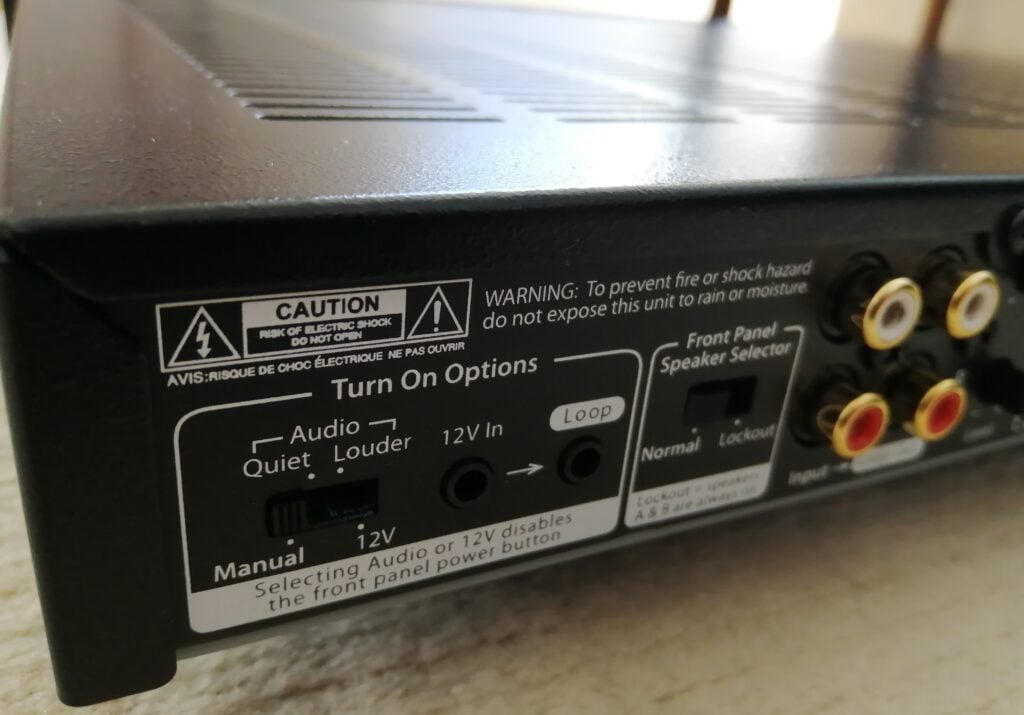
I also drove my front left and right 4-ohm S150s with the v.2 for pure two-channel music from CD. Drawing a comparison with my existing Parasound HCA-2003 300W per channel monster, the 275 was still articulate, yet pleasingly neutral and wonderfully dynamic. There was, however, a slight detectable brashness in the vibrato of Lynne Dawson’s exquisite soprano voice in the Christe Eleison of John Eliot Gardiner’s superb recording of Bach’s Mass in B Minor (Archiv). Here, I would have preferred a little more air and subtlety. But remember this is an $750 slimline amplifier, not a $4,000 reference behemoth. Another striking feature is the v.2’s sheer loudness capability as mid-range organ pipes swamped my demo room without fear of languishing as Samuel John Swartz plays Tournemire’s Improvisation on Victimae Paschali (Perpetua).
The Edge’s guitar on the U2 track, One Tree Hill, hardly the world’s greatest recording, is resolved with beautiful and isolated rhythmic modulations hovering slightly above a mix of tight bass and convincing snare drum attack and decay. Again, not what one might expect from this price class of amplifier. I am always hot on the trail of amplifiers which can breathe new life into dynamically restricted, radio-friendly pop.
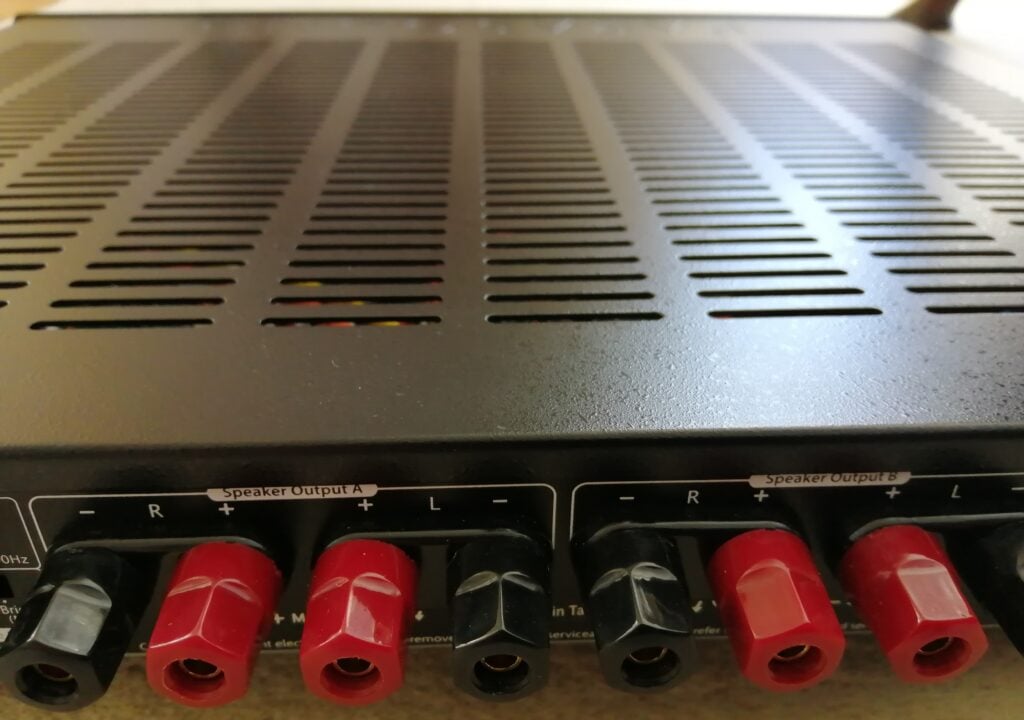
Conclusion
Putting any steel box from the Parasound factory through its paces is always an exciting prospect. Whether removing a pocket-size ZoneMaster or home-demolishing Halo from its packaging, you know you are dealing with robust and unflappable kit. Most satisfying, though, is the extreme sound quality this Bay Area team manages to extract from some of the most modest of physical profiles. The New Classic 275 v.2 is no exception to the rule. Stack two of these skinny slabs in your rack for Atmos flyovers, or plonk it on your desk with a streamer for a highly rewarding bask in your jazz collection. I don’t think you will be disappointed.
Description
Parasound 200 PRE
Frequency Response:
20 Hz – 20 kHz, +0 / -0.05 dB
10 Hz – 80 kHz, +0 / -3 dB
Total Harmonic Distortion: (20 Hz – 20 kHz)
< 0.03 %
Interchannel Crosstalk:
75 dB at 20 kHz
Input Sensitivity:
250mv = 1V output
Total gain = 12 dB (volume set to 100)
Unity Gain = Volume set to 76
Maximum output = 3.5V
Phono Stage Sensitivity / Input Impedance
MM: 40 dB / 47 k Ω
MC: 50 dB / 100 Ω
Input Impedance:
24k Ohms
Output Impedance:
470 Ohms
S/N Ratio – Line Inputs:
> 100 dB, input shorted, IHF A-weighted
> 90 dB, input shorted, unweighted
S/N Ratio – Digital Inputs:
> 100 dB, input shorted, IHF A-weighted
> 90 dB, input shorted, unweighted
DC Trigger Output:
12 Vdc, 50ma
AC Power Requirement:
10 Watts maximum
<0.5 Watts in standby
90-250 VAC 50/60 Hz (automatic)
Dimensions:
Width: 17.25″ (437 mm)
Depth: 14.25″ (362 mm)
Depth: 16″ (369 mm) with cables connected
Height, with feet: 2.5″ (105 mm)
Height, without feet: 1.75″ (89 mm), 1U
Weight:
Net: 11 lbs (5 kg)
Shipping: 17 lbs (7.7 kg)
- Burr-Brown 192kHz-24 bit DAC from the Halo P 5
- USB, Optical and Coax digital audio inputs
- 4 Analog audio inputs
- Phono input for MM or MC cartridges
- Pure analog signal path from input to output
- Analog bass management w/ variable 20-140Hz high pass crossover
- Subwoofer On/Off & level by remote control
- 80Hz low pass subwoofer output
- Full range subwoofer output can also be used for a mono listening area
- Variable and fixed stereo outputs
- Bypass input for surround sound or music streamer integration
- Default turn on volume memory
- Favorite volume memory with remote control button
- Input level matching (source volume offset)
- Bass, treble and balance adjustments by remote control
- Front panel LCD display with dimming
- 2-way RS232 w/ exact volume control & feedback
- Control4 Driver available here
- Rename inputs to match connected source
- 12dB auto gain for front panel AUX to match levels of other sources
- Dedicated headphone amplifier
- Back-lit remote control with discrete buttons
- 12V trigger output
- Rear panel IR input
- 0.5w standby power consumption meets Energy Star & EU specs
- 1U rack mount kit available separately (Model RMK11)
NewClassic 275 v.2
-
90 watts x 2 into 8 Ω (all channels driven)
- 150 watts x 2 into 4 Ω or 2 Ω (all channels driven)
- 200 watts x 1 bridged into 8 Ω or 4 Ω
- 20 amps peak current per channel
- 2 Ohm stable operation with load selector switch
- Two pairs of speaker outputs with front panel A/B buttons
- Rear-mounted lockout switch disables front A/B buttons
- High pass filter, switchable for 20Hz or 40Hz
- Automatic on/off by DC trigger with looping output
- Automatic on/off by audio signal with 2 sensitivity settings
- Fully discrete circuitry with high current toroid transformer
- Bridging switch for stereo or mono operation
- Efficient, low heat design
- DC Servo and relay protection circuits
- Rear-mounted left and right gain controls
- Standby, channel status and high temperature indicators
- Gold-plated RCA input jacks
- Heavy duty 24k gold-plated 5-way speaker terminals
- 115/230v selector on rear panel










